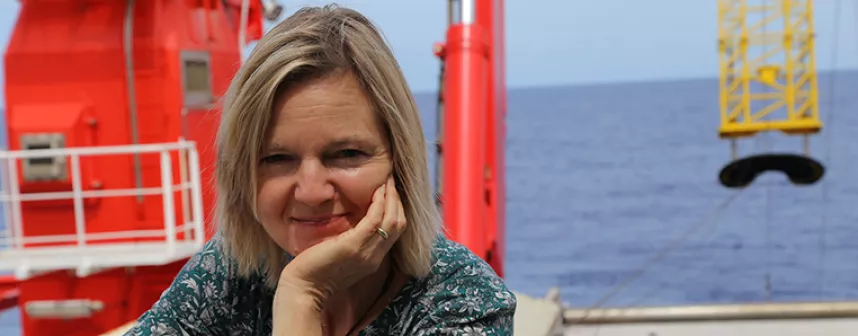Amazon in bottles
January 2nd, 2019
Science needs staying power. Prof. Dr. Andrea Koschinsky, geochemist at Jacobs University Bremen, returned from her research trip to the Amazon estuary with thousands of samples. Their evaluation takes years.
Some contain only a few milliliters, others a quarter of a liter. Already on board, some of the estuary water samples of the Amazon were shock-frozen, sometimes at minus 80 degrees Celsius. Now the water samples are stored in the freezers of the Ocean Lab at Jacobs University - in hundreds of small bottles. The sediment samples from the seabed are stored not far away in small doses weighing 100 grams. Nobody counted them, but there are probably several thousand of them. "They will keep us busy for several years," says Andrea Koschinsky, Professor of Geochemistry at Jacobs University.
, Sediment core © Prof. Dr. Andrea KoschinskyThe samples are the result of cruise M147 on the Meteor research vessel into the estuary of the world's most water-rich river. A team of scientists led by Koschinsky and Professor Martin Frank from the GEOMAR-Helmholtz Centre for Ocean Research in Kiel spent several weeks in the region in April and May. The almost 7000 kilometer long river transports large quantities of dissolved metals such as iron or copper and organic substances far into the sea. It is the aim of the researchers to better understand the material cycle and to determine the actual state in order to be able to recognize changes through human action.
For Andrea Koschinsky, the expedition was the fulfillment of a dream. The experienced scientist has often traveled the oceans, but never in the mouth of the Amazon. "The region with its huge rainforest system fascinates me," says the 54-year-old, who has also researched the confluence of the Rio Negro and the Rio Solimões to the Amazon not far from the jungle city of Manaus. The Solimões originates in the Andes, it carries suspended rock material that gives its water a whitish color. The Negro, on the other hand, comes from the rainforest, its water is dark, acidic and rich in organic material. "When they merge, it's like a chemical factory: two different systems react until the entire system is in a new equilibrium again," says Koschinsky.
, Sample filtration: Rebecca Zitoun from the Jacobs University team filters the particle-rich water of the Amazon before it is conserved for analysis in the local laboratory. © Prof. Dr. Andrea KoschinskyIt's not much different when the Amazon and Atlantic meet, with their different pH values and ion contents. The freshwater of the river is rich in organic matter, unlike the saltwater of the sea. "The Amazon is the most important contributor to the biological cycles of the Atlantic," says Koschinsky. Up to 200,000 cubic meters per second flow into the sea during the rainy season. These enormous masses form a plume drifting far north with the current, in which the chemical and biological processes are influenced several hundred kilometers far beyond the estuary by the nutrients, metals and particles introduced with the river water. In the river as well as in the mixed zone of salt and fresh water, the scientists took samples at different water depths.
For the crew around Captain Hammacher and the researchers on board the meteor, the power of the Amazon soon proved to be a challenge. Unregistered river shoals made navigation difficult, the brown river water quickly brought the filters to their load limits, the tide moved so fast that sampling along the lines of changing salinity became a race against time. At night-time, intensive fishing activities kept the crew in suspense.
, Meteor in the brown water of the Amazon estuary © Prof. Dr. Andrea KoschinskyThe logistics following the trip also proved to be demanding. In order to bring the valuable samples home safely, they remained in the Meteor's refrigeration and freezing rooms until they reached the port of Las Palmas on Gran Canaria in summer. From there they were delivered by courier service to the German research centers, maintaining the cold chain so that the unstable compounds in the frozen water samples were not damaged. The less susceptible sediment samples were transported in containers.
"Each sample is a puzzle piece in a puzzle with well over 1000 pieces," says Andrea Koschinsky. Several students at Jacobs University are involved in the analysis of the samples and the creation of a piece of the puzzle as part of their bachelor's theses. The fact that they are involved in research projects is a special feature of the private university. "This often results in publications in scientific journals," says Koschinsky.
, Glovebag: Rebecca Zitoun from the Jacobs University team processed samples under exclusion of atmospheric oxygen in a so-called Glovebag. © Prof. Dr. Andrea KoschinskyThe analysis of the samples is time-consuming and requires patience and care. It takes years for all puzzle pieces to be created and assembled into a complete work. The scientists are interested in an overall picture of the mass transfer processes in the Amazon estuary. However, the samples taken during the journey only reflect a snapshot that is not representative for larger periods of time.
In order to determine the influence of deforestation, the construction of dams or gold mining in the Amazon on chemical and biological processes, further measurements are needed - and at a different time when less water flows. This time Andrea Koschinsky and her colleagues were on the road during the rainy season. Next time it should be the dry season. The researcher is currently preparing the next sampling campaign and is working on a new grant application. At the end of 2020, she hopes, it could be back to the Amazon.
, Peter Neumann (1st engineer), Christian Rohleder (meteorologist), Andrea Koschinsky and Captain Rainer Hammacher (from left to right) © Clive Maguire